The Future of Diagnostic Tools in the Microbial Identification Market By 2022 to 2032
The global microbial identification market is on a robust growth trajectory, with a forecasted valuation of approximately USD 10.7 billion by 2032. The market, which was valued at USD 3.7 billion in 2022, is set to expand at a compound annual growth rate (CAGR) of 11.3% over the next decade.
This impressive growth is driven by the increasing demand for microbial identification products across a diverse range of end-user sectors. Pharmaceutical and biotechnology companies, food and beverage industries, water and environmental management, diagnostic laboratories, and independent research facilities are all contributing to this upward trend.
Get Access to Sample Report Now: https://www.futuremarketinsigh....ts.com/reports/sampl
Key Drivers of Market Growth:
Pharmaceutical and Biotechnology Sector: The need for accurate microbial identification is crucial for drug development and ensuring the safety of biotechnological products. As research and development in these fields advance, so does the demand for sophisticated microbial identification solutions.
Food and Beverage Industry: Ensuring the safety and quality of consumable products remains a top priority. The rising emphasis on food safety regulations and quality control is significantly boosting the demand for microbial identification technologies.
Water and Environmental Management: With growing concerns about water contamination and environmental safety, there is an increasing need for efficient microbial monitoring and identification to ensure public health and compliance with environmental regulations.
Diagnostic Laboratories and Research Facilities: As diagnostic testing and research become more complex, laboratories require advanced microbial identification tools to enhance their diagnostic capabilities and support scientific advancements.
The market's expansion reflects a broader trend towards heightened awareness and proactive measures in microbial management. Companies and institutions are increasingly investing in advanced technologies to address microbial contamination and ensure safety and compliance across various sectors.
Future Outlook:
The global microbial identification market is expected to witness continued growth as technological innovations and increasing awareness about microbial risks drive demand. The integration of artificial intelligence (AI) and machine learning (ML) in microbial identification systems is anticipated to further enhance the capabilities of these solutions, offering even greater precision and efficiency.
Competitive Landscape:
The microbial identification market is highly fragmented due to the presence of numerous competitors. To address consumer needs and broaden their market reach, companies in this sector are employing strategies such as mergers and acquisitions, partnerships, collaborations, and launching new products.
Notable developments by key players in the microbial identification market include:
In August 2022, Bruker Corporation unveiled several innovations at the International Mass Spectrometry Conference (IMSC 2022), including the nanoElute 2 nano-LC, MetaboScape, and TASQ 2023 software. These advancements support fluxomics and enhance research capabilities in protein-protein interactions (PPIs) and metaproteomics applications.
In June 2021, Danaher Corporation announced its acquisition of the privately-held company Aldevron for approximately $9.6 billion in cash. The acquisition is expected to be financed through Danaher's available cash reserves and/or commercial paper revenues.
Key Companies Profiled:
Danaher Corporation
Bruker Corporation
Thermo Fisher Scientific
Siemens Healthineers
Shimadzu Corporation
QIAGEN N.V
bioMerieux S.A.,
Merck & Co Inc.,
Biolog, Inc.,
Becton, Dickinson, and Company
Beckman Coulter
Wickham Laboratories
VWR International, LLC.
MIDI Inc.,
Siemens Healthcare
Charles River Laboratories Inc
Key Market Segments Covered in Microbial Identification Industry Research:
By Product:
Bacterial Identification Systems
Microbial Enumeration Systems
Bacterial Resistance Identification Systems
Microbiology Analyzers
Parasitology Analyzers
By Methods:
Phenotypic methods
Proteotypic Methods
Genotypic methods
By Application:
Diagnostic Application
Environmental Application
Food and Beverages Testing
Pharmaceutical Application
Others
By End User:
Pharmaceutical and Biotechnology Industry
Food and Beverage Industry
Water and Environment Industry
Independent Research Laboratories
Diagnostic Laboratories
hospitals
Others
By Region:
North America
Latin America
Europe
South Asia
East Asia
Oceania
Middle East and Africa (MEA)
Tycka om
Kommentar
Dela med sig









 1 (877) 773-1002
1 (877) 773-1002